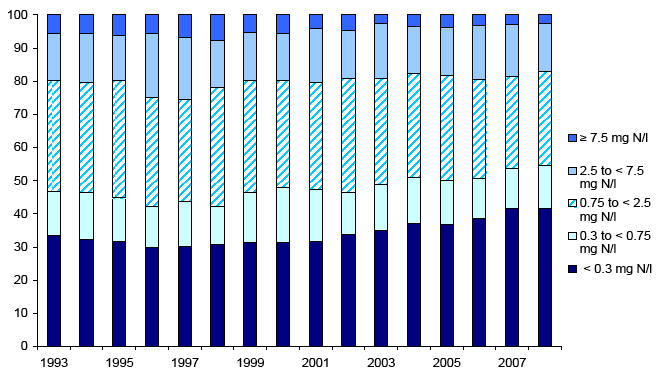Key Scottish Environment Statistics 2009
Annual publication containing summary of key statistics on environmental trends in Scotland
Water
Nitrate Concentrations in Rivers 5: 1993-2008
Distribution of mean nitrate concentrations, percentage of sites 6 within each band

Percentage of sites 6 within each band
| Band | 1993 | 1995 | 2000 | 2005 | 2006 | 2007 | 2008 | |
|---|---|---|---|---|---|---|---|---|
>=7.5 mg N/l |
6 |
6 |
6 |
4 |
3 |
3 |
3 |
|
2.5 to <7.5 mg N/l |
14 |
14 |
14 |
15 |
16 |
16 |
15 |
|
0.75 to <2.5 mg N/l |
33 |
35 |
32 |
32 |
30 |
28 |
28 |
|
0.3 to <0.75 mg N/l |
14 |
13 |
17 |
13 |
12 |
12 |
13 |
|
<0.3 mg N/l |
33 |
32 |
31 |
37 |
38 |
42 |
42 |
|
The enrichment of waters by nutrients, such as nitrates and phosphates, may lead to damage to the aquatic environment through the accelerated growth of algae and other plant life. The rapid growth and subsequent decay of plant organisms depletes oxygen levels, and this can have harmful effects upon fish and other aquatic life. This process is termed eutrophication.
High nitrate levels tend to have a greater impact on marine and coastal waters than on freshwater; a substantial part of the nitrates in freshwater will eventually reach the sea. The main source of nitrates in freshwater is agriculture.
Concentrations of nitrate below 0.3 mg N/l are considered to be natural or background levels 7; over 40% of the sites met this classification in 2008. Between 1993 and 2008 the percentage of sites with average nitrate concentrations >= 2.5 mg N/l rose to a peak of 25.5% in 1997. In 2008, this percentage was 17.1%.
Regulations have been made designating 14% of the area of Scotland 8 as Nitrate Vulnerable Zones ( NVZs) 9. In NVZs mandatory rules on farming practices aim to reduce nitrate water pollution from agricultural sources.
There is a problem
Thanks for your feedback